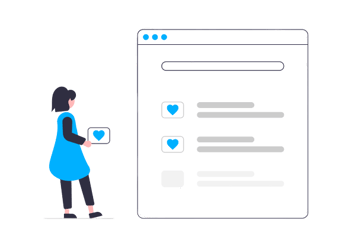How do I deal with bad customer service?
Unhappy customers are an unavoidable reality of business. Servicing these customers is never easy but it’s important and can dictate the success and future growth of your business.
You may hear customers complain about ‘bad customer service but what does this mean and what can a business do to turn their customer service around? Customers can be unhappy for all kinds of reasons but if you think you have bad customer service, you need to fix it straight away.
Customer service needs to make a good impression so if you think your brand could be doing better, here’s what you need to know:
Types of challenging customers:
Before you can appease an unhappy customer, and lift your customer service to meet expectations, you need to figure out how they’re feeling and what they expect from you. The most common types of negative customers include:
Impatient customers
Increasingly, people want immediate results, especially when seeking customer service. An impatient customer will likely complain about bad customer service when the business takes too long to respond, get to the heart of the issue, and offer a suitable solution. A lack of speed and efficiency are key frustrations for the impatient customer.
Indecisive customers
If customers are taking a while to commit to a product or service, they likely have questions or concerns that you haven’t yet answered. In these scenarios, bad customer service can stop you from learning how to appropriately help the individual, by asking the wrong questions or becoming frustrated with their cautious approach. Servicing these customers can be challenging because their needs are ever-evolving and they may struggle to commit to a course of action. They need a lot more direct assistance and can benefit from being sent links to resources where they can self-educate and learn.
Angry customers
Whether it’s justified or not, every business will have angry customers at some point. For whatever reason, they’re unsatisfied with their experience as a customer and this has become an emotive response. Bad customer service with an angry customer can be the service personnel shutting down, enabling the customer to control the dialogues, not explaining the next steps or, becoming angry too.
How to improve customer service for unhappy customers
If your customer service needs improvement, you’ll need to ensure your team is properly equipped and trained to handle unhappy customers. When customer service teams are underperforming, it’s often due to a lack of resources or inadequate instruction, so it’s worth investing in them before you do anything else.
Poor customer service can also stem from not meeting the customer’s expectations. Most people are reaching out to customer service because they have an issue and the quicker you can resolve this to the customer’s satisfaction, the better.
Fortunately, no matter what the customer’s problem is, there are several steps your team can take to mitigate the damage. Let’s take a look.
Respond quickly
When a customer reaches out with a complaint or a problem, you should respond as soon as possible. If you take too long to get in touch with the customer, they’ll feel ignored and frustrated, leading them to see your customer service as poor.
Setting up automated responses can be beneficial because they assure customers that you’ve received their message and that someone from the team will get back to them soon. Sometimes this assurance is enough to calm a dissatisfied customer down because at least they know help is on the way. Integrating this with an internal alert system means reps are notified of a conversation that needs to take place and if that system is cloud-based it can happen in real-time.
Actively listen
Perhaps the most important step to take when dealing with negativity is to listen to the customer. It may seem obvious, but many brands fail to achieve this and jump straight to handing out solutions that don’t really tackle the problem.
If you want to improve the customer’s experience, you need to allow them to fully explain the situation and what exactly they want you to do. Not only does this give you the information you need to resolve the problem, but it also makes the customer feel valued and heard.
Remember that the issue the customer has come to you to resolve might not be the entire picture. It’s a good practice to ask several clarifying questions about the problem to get to the heart of the challenge. This may uncover an underlying issue that will be better to fix and may help you find the most suitable solution more quickly. Here’s an example:
Customer “I want a refund…”
Service “No problem I can do that for you, out of interest why do you want a refund?”
Customer “The product doesn’t work…”
Service “That’s no good, does it not work as intended or is it broken?”
Customer “I bought it to do X, but it’s actually designed to do Y.”
Service “We actually have a Z in stock that can do Y, would you like me to send you one? If it works simply send us back A and we can invoice the difference.”
Customer “That would work perfectly, thank you.”
In the above example, a naturally curious service team not only solved the customer’s underlying issue but found a better solution and made the company more revenue.
Take ownership of your mistakes
It can be easy to be defensive when a customer complains, but it’s important to take responsibility when things aren’t as they should be. If your customer service hasn’t been operating at its best, you will have to take ownership of that and admit that there’s room for improvement. In doing this, you’ll demonstrate to customers that you have seen the problems and are prepared to make relevant changes.
Customers know there’s no such thing as perfection, but a brand that owns up to its mistakes and seeks to remedy them is far more appealing than one that stubbornly sticks to its claims.
Be patient and empathetic
When customers are upset, there can be a lot of emotion surrounding the situation. To handle these interactions well, you must be calm, patient, and empathetic. Put yourself in the customer’s shoes and find out what they need from you.
In a lot of cases, customers just want to be heard and understood so take the time to pause, let them vent, and then reassure them that you will address their concerns.
Turn negativity into positive growth
No one likes to hear bad feedback but it’s an inevitability in business. So when customers complain, instead of letting it get under your skin, use it to make improvements and refine your operations.
Customer feedback is a powerful tool for growth because it highlights what works well and what doesn’t. Don’t be afraid of feedback, implement a strategy that harnesses its power instead.
Deliver on your promises
When a customer is unhappy, you need to tell them what you’re going to do about the problem. It’s good practice to discuss the next steps with them so they know exactly what to expect and when. Outlining specific next steps and sticking to the promised timeframes is important to restoring faith in your business.
The key thing to remember is that you must deliver on these promises – no matter what. Don’t disappoint your customer again, but rather, set up automatic workflows and assign tasks to team members so that every promise is fulfilled.
Use customer data to personalise the Customer Experience
When a customer interacts with your business in any way, it’s a good idea to record the relevant information in your CRM and Customer Feedback Management software (CFM). This way, every time a customer reaches out with a complaint, you can see what has already happened in their customer journey and what still needs to be done. When resolving a customer complaint, knowing this information can save time for both the customer and your employees.
To improve your customer service and better connect with your customers, Review Tui has all the tools you need to begin. You can tap into insights, find out what motivates your audience, and find out what sticking points are causing the most friction for customers.



